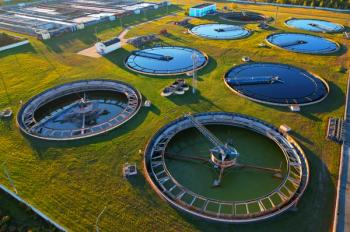
The LCGC Blog: You Can Perform Multiple Reaction Monitoring for an Intact Antibody on a Triple Quadrupole Mass Spectrometer
Virtually exclusively, liquid chromatography–mass spectrometry (LC–MS)-based assays for protein quantitation rely on bottom-up strategies, where the protein is initially digested into constituent peptides during sample preparation. Top-down intact protein quantitation, especially using affordable, low resolution triple quadrupole (QQQ) mass spectrometers, has been largely unexplored.
Virtually exclusively, liquid chromatography–mass spectrometry (LC–MS)-based assays for protein quantitation rely on bottom-up strategies, where the protein is initially digested into constituent peptides during sample preparation. This generally limits the ability to perform absolute quantitation; many bottom-up strategies rely on the determination of some ratio of treated versus untreated using isotope labeling. Top-down intact protein quantitation, especially using affordable, low resolution triple quadrupole (QQQ) mass spectrometers, has been largely unexplored.
In the past couple of years, we have been focusing on the use of LC–QQQ-MS and multiple reaction monitoring (MRM) to target and quantify intact proteins. We have found that unique and reproducible MRM precursor-to-product ion transitions can be generated for intact protein ions generated by electrospray ionization (ESI) (1).One or more of the different multiple charge states generated by ESI can be targeted. Two key operational parameters are collision gas pressure and collision energy. We have found that as the molecular weight of the target protein increases, the collision gas pressure also must be increased (Note: Not all triple quadrupole instruments allow the user to vary collision gas pressure). We have also found that moderate collision energies, where some precursor ion signal remains, are needed to create a reasonable number of high intensity and reproducible MRM transitions.
We initially focused on a set of standard model proteins (ubiquitin, cytochrome c, myoglobin, and others) ranging in molecular weight from 11 – 28 kDa. Once we demonstrated that MRM transitions could be generated and used to obtain good specificity, linearity, accuracy, and precision, we then focused on evaluating mass spectrometry-compatible separation conditions (2). Much of the past literature on the chromatography of intact proteins did not use MS detection. We found that high efficiency reversed phase separations could be obtained by combining 0.1 – 0.5% formic acid with just a little bit (0.01%) of trifluoroacetic acid in the mobile phase (pH 2). This combination yielded maximum intensity, minimum carryover, and good peak shape. Limits of detection were modest and in the low nanogram on-column regime.
After exploring solution phase conditions, we moved to the gas phase, to study protein ion transmission in the QQQ-MS (3). We evaluated the effect of quadrupole resolution settings on ion yield at the detector. We studied the effect of different collision gases (N2, Ar, and He) and pressures on ion scattering and charge transfer processes, which could reduce sensitivity. Clearly, modern QQQ-MS instruments are engineered with small molecules in mind. In the end, we found that there probably is an opportunity for someone to build a QQQ-MS system dedicated to use with intact proteins; the ion transmission behavior for intact proteins is quite different than for small molecules.
Most recently, we have completed a study showing that reproducible MRM transitions can be generated for intact proteins ranging from 68 – 150 kDa (4). We explored various additives and their effect on protein supercharging and generated ion intensity. Some of these were more common supercharging additives, such as dimethyl sulfoxide (DMSO) and meta-nitrobenzyl alcohol (m-NBA); we also showed some exceptional effects from the addition of trifluoroethanol (TFE) to the mobile phase. TFE is an interesting additive, as it is known to induce conformational changes in proteins and peptides. In our study, we found it could provide significant increases in the charging of proteins, as well as gains in sensitivity for the model high molecular weight proteins tested. In the end, detection limits still bottomed-out at the low nanogram on-column levels.
The fact that 150 kDa antibodies can be potentially targeted using QQQ-MS is a key message to build upon. There are many more QQQ-MS instruments out there available for use, compared to the high resolution mass spectrometers typically used for top-down investigations. Certainly, there will be some limits in the ability to elucidate and target different proteoforms of a protein, but I would surmise there are plenty of cases where that is okay. Perhaps resolution of different proteoforms can be achieved during sample preparation or during the separations ahead of the MS detector.
Another aspect of targeting these large intact proteins, is that rich charge state distributions are generated by ESI, especially in the presence of choice additives. We have shown that multiple multiple reaction monitoring (MRM) transitions can be summed to increase sensitivity; the potential for targeting different or multiple charge states (each with its own unique set of MRM transitions) to increase signal and specificity appears to be a promising strategy, which has not been fully explored.
We are currently moving toward real-world applications, specifically to targeting a set of putative cancer biomarkers from serum and urine. This has its own challenges, particularly in the optimization of sample preparation procedures to enrich the target proteins prior to LC–QQQ-MS – to reach the necessary detection limits. Still, I believe there is a lot of opportunity. Intact protein quantitation has not been heavily investigated, much less using a QQQ-MS. The potential to remove the need for protein digestion prior to LC–MS-based quantitative analysis is alluring, but intact proteins are certainly more of a challenge to handle than small molecules. From the potential for disease diagnosis and prognosis based on monitoring levels of biomarkers, to the burgeoning protein pharmaceutical market, there is no shortage of needs for new, and more efficient means for protein analysis.
References
- E.H. Wang, P.C. Combe, K.A. Schug, J. Am. Soc. Mass Spectrom. 27 (2016) 886-896.
- E.H. Wang, Y. Nagarajan, F. Carroll, K.A. Schug, J. Sep. Sci.39 (2016) 3716-3727.
- E.H. Wang, D.K. Appulage, E.A. McAllister, K.A. Schug, J. Am. Soc. Mass Spectrom. 28 (2017) 1977-1986.
- D.D. Khanal, Y.Z. Baghdady, B.J. Figard, K.A. Schug, Rapid Commun. Mass Spectrom. (2019). In Press. doi: 10.1002/rcm.8418.
Kevin A. Schug is a Full Professor and Shimadzu Distinguished Professor of Analytical Chemistry in the Department of Chemistry & Biochemistry at The University of Texas (UT) at Arlington. He joined the faculty at UT Arlington in 2005 after completing a Ph.D. in Chemistry at Virginia Tech under the direction of Prof. Harold M. McNair and a post-doctoral fellowship at the University of Vienna under Prof. Wolfgang Lindner. Research in the Schug group spans fundamental and applied areas of separation science and mass spectrometry. Schug was named the LCGC Emerging Leader in Chromatography in 2009 and the 2012 American Chemical Society Division of Analytical Chemistry Young Investigator in Separation Science. He is a fellow of both the U.T. Arlington and U.T. System-Wide Academies of Distinguished Teachers.
Newsletter
Join the global community of analytical scientists who trust LCGC for insights on the latest techniques, trends, and expert solutions in chromatography.





